Why this resume works
- Quantifies accomplishments: Listing quantifiable accomplishment in their work history, such as increasing readership by 30% and collaborating with over 10 brands showcases the applicant’s significant impact and value.
- Showcases career progression: Moving from a copywriter to a freelance writer role illustrates clear career progression and growing responsibilities in content creation and brand collaboration over time.
- Uses action-oriented language: Using action verbs like “published,” “boosted,” and “generated” effectively conveys initiative and results-oriented achievements.
More Freelance Writing Resume Examples
Check out our freelance writing resume examples to discover how to showcase your writing skills, diverse experience, and creativity. Use these samples to help you create a resume that attracts clients across various industries.
Content writer
Why this resume works
- Effective use of keywords: The applicant expertly integrates industry keywords like “content strategy” and “creative storytelling,” ensuring their resume navigates applicant tracking systems effectively.
- Shows digital literacy: Mastery of SEO tools and social media platforms highlights digital literacy, showing readiness for tech-driven roles.
- Puts skills at the forefront: By prioritizing skills such as “content development” and “market research,” the resume employs a strategic skills-based format ideal for showcasing competencies upfront.
Technical writer
Why this resume works
- Points to measurable outcomes: By showcasing how their user guides reduced support calls and their high user satisfaction rates, the applicant clearly communicates their impact through measurable results.
- Demonstrates language abilities: The applicant’s language skills in Spanish and French contribute to potential cross-cultural communication in global projects.
- Includes a mix of soft and hard skills: Combining technical writing with communication skills indicates a balance of analytical prowess and interpersonal skills important for effective teamwork.
Editor
Why this resume works
- Showcases impressive accomplishments: With accomplishments like reducing editorial error by 30%, the applicant clearly indicates a knack for delivering exceptional results.
- Lists relevant certifications: Earning certifications such as an Advanced Editorial Certification and an SEO Expert Certification reinforce the applicant’s expertise in editing and digital marketing realms.
- Emphasizes leadership skills: Proven leadership skills are evident as the applicant supervised a team of five junior editors, significantly boosting output and reducing editorial errors.
Freelance Writing Resume Template (Text Version)
Jane Jefferson
Silverlake, WA 98291
(555)555-5555
Jane.Jefferson@example.com
Skills
- SEO Optimization
- Content Creation
- Copywriting
- Editing
- Research
- Brand Collaboration
- Time Management
- Digital Marketing
Languages
- Spanish – Beginner (A1)
- French – Beginner (A1)
- German – Intermediate (B1)
Professional Summary
Dynamic freelance writer with 6 years’ experience. Expertise in content creation and SEO optimization. Proven track record of boosting readership and engagement.
Work History
Freelance Writer
Creative Content Hub – Silverlake, WA
June 2022 – June 2025
- Published 50+ articles monthly.
- Increased readership by 30%.
- Collaborated with 10+ brands.
Content Specialist
Digital Insights Co. – Spokane, WA
June 2019 – May 2022
- Managed content calendar.
- Boosted SEO rankings by 25%.
- Coordinated with creative teams.
Copywriter
Innovate Media Group – Tacoma, WA
June 2017 – May 2019
- Crafted engaging headlines.
- Generated k in ad revenue.
- Edited 100+ scripts monthly.
Certifications
- Certified Content Marketer – Content Marketing Institute
- SEO Optimization Expert – SEO Academy
Education
Master of Arts Creative Writing
University of California Los Angeles, CA
May 2017
Bachelor of Arts English Literature
California State University Long Beach, CA
May 2015
Related Resume Guides
Advice for Writing Your Freelance Writing Resume
Learn how to write a resume tailored for freelance writing gigs. Discover tips that help your creativity and writing skills shine, making your resume stand out in the bustling world of freelancing. Whether you’re crafting compelling content or penning captivating stories, we’ve got advice to make your experience leap off the page.

Showcase your portfolio or projects
Having a portfolio or projects section is really important for freelance writing and other creative roles. It helps you show what you can do, often better than just listing your skills. When clients or employers can see your work, they get a better idea of your style and talent. Portfolios prove that you have experience and that you can deliver what you’re promising.
For freelance writers, it’s a good idea to link to an online portfolio on platforms like Behance, Dribbble, or your personal website. You can also include select projects in your resume. Don’t shy away from adding freelance gigs, academic projects, or even side projects—they all count.
List projects like you would work experiences. Include the project name, who it was for (if relevant), a short description of what it was about, and what you did to make it successful.
By organizing your projects this way, you’re not only showing off your best work but also making it easy for others to understand what you’ve accomplished and how you’ve made an impact in each project. This structured approach helps clients see the value you bring as a freelance writer.
Example of a projects section
Content Creation for Health and Wellness Blog
Wellness World
March 2023 – June 2023
- Wrote and edited over 20 articles focusing on mental health, nutrition, and fitness tips.
- Increased blog traffic by 35% through SEO optimization and engaging storytelling.
- Collaborated with graphic designers to create visually appealing article layouts.
Technical Writing for Software Documentation
Tech Innovations Inc.
August 2022 – February 2023
- Developed comprehensive user manuals and API documentation for a new software release.
- Worked closely with engineers to ensure technical accuracy and clarity in all materials.
- Streamlined the documentation process, reducing production time by 20%.
Looking at professional resume examples can give you ideas on how to make your own resume stand out for different jobs.
Emphasize your most relevant skills
Freelance writing can be both creative and technical, requiring a mix of skills to succeed. It’s important to highlight both types of skills in your resume.
Technical skills might include language mastery or software tools like Microsoft Word and Google Docs. Creative abilities involve storytelling, idea generation, and crafting engaging content. These two skill sets work together to make your writing strong and impactful.
Having a skills section on your resume is a smart move for freelance writers. This section can list the software you use along with any artistic talents like editing or research skills that help your writing shine. By clearly showing these skills, you create a clear picture of what you bring to the table as a writer.
Weaving these skills into your work experience bullet points makes them even more powerful. Rather than simply listing tasks you’ve done, talk about how you used certain skills to achieve great results in past projects.
For example, mention how using specific writing techniques helped draw readers in or how you used editing tools to improve story quality. This approach helps potential clients see exactly how your skills translate into successful outcomes.
Choose a resume format that highlights your writing skills and showcases successful projects clearly and effectively.
Choose a professional resume template
When picking a resume template for freelance writing, go for one that mixes creativity with professionalism. A clean and structured design makes your resume appealing without being too much.
Seek templates that use visual hierarchy to guide the reader’s eye smoothly across the page. This involves using clear headings, bullet points, and ample white space to keep things organized. Stay away from overly decorative fonts or colors, as they might distract from your content.
It’s also key to select a format that works well with applicant tracking systems (ATS). Many freelance writing gigs still require resumes through these systems, so a simple layout is best. Stick with standard fonts like Arial or Times New Roman and steer clear of complex graphics that may not translate well digitally.
Choosing such a template ensures your resume looks professional while staying easy for both humans and machines to read.
Create a standout resume in minutes! Use our Resume Builder to quickly organize your writing skills and experiences, making it easy for potential clients to see your talent.
Format your resume properly
Properly formatting your resume is key for freelance writing jobs, as it helps make your experience clear and appealing to potential clients. If you have lots of writing experience, a chronological resume format shows steady growth in projects. For less experienced writers, a functional format works better, highlighting skills like creativity and research over job history.
5 resume formatting tips
- Use clear section headings: Structure your resume with defined sections like “work experience,” “skills,” and “portfolio.”
- Select a consistent font: Choose fonts like Calibri or Arial in 10-12 pt. size for readability.
- Use bullet points: Employ bullet points to list achievements and responsibilities for quick scanning.
- Limit resume to one page: Keep it to one-page unless you have extensive freelance writing experience.
- Ensure proper spacing and alignment: Use uniform spacing and alignment for a clean and professional presentation.
Don’t let ATS software reject your resume! Our ATS Resume Checker makes sure your resume is formatted right and has the best keywords.
FAQ
Do I need to include a cover letter with my freelance writing resume?
Yes, including a cover letter with your freelance writing resume can make a big difference in landing projects or gigs.
A cover letter lets you highlight your writing style, pitch relevant skills, and explain why you’re the perfect fit for the client’s needs or project goals.
For instance, if the client specializes in a particular niche (like tech, travel, or finance), you can emphasize your expertise or passion for that subject in more detail.
You can also use this opportunity to showcase your voice and creativity—qualities that are often key in freelance writing roles.
Check out these cover letter examples to get started.
To stand out, avoid generic templates and tailor your cover letter using a Cover Letter Generator to match the tone of the client’s brand while addressing their specific requirements from the job posting.
How long should a freelance writing’s resume be?
For a freelance writer, aim for a one-page resume that highlights your most compelling work and relevant skills. Focus on showcasing your writing versatility by including diverse samples or links to published works in different genres or industries.
If you have extensive experience or specialized achievements worth mentioning, a two-page resume is acceptable, but make sure every detail is relevant.
Consider emphasizing key projects, notable clients, and any unique expertise like SEO writing or content strategy. Prioritize recent and impactful roles that demonstrate your capability as a freelance writer.
Explore our guide on how long a resume should be for examples and tips tailored to your career stage, helping you decide the best approach for presenting your professional journey effectively.
How do you write a freelance writing resume with no experience?
To craft a freelance writing resume, even if you have no experience, emphasize your skills, education, and any projects that demonstrate your writing talent. Check out these tips for a resume with no experience to help you get started:
- Highlight transferable skills: Emphasize strong communication, research abilities, creativity, and attention to detail. These skills are important for freelance writers and can be developed through various experiences.
- Feature personal projects: Include blogs, articles, or any writing samples you’ve created independently. This demonstrates initiative and gives potential clients a taste of your style.
- Focus on education: If you have taken courses in English, journalism, or creative writing, list them prominently. Mention any workshops or seminars that improved your writing capabilities.
- Showcase volunteer work: Volunteer as a writer for nonprofits or community organizations; this provides real-world experience even if unpaid. Highlight these roles in your resume.
- Include relevant software skills: Skill in word processing tools like Microsoft Word or Google Docs is essential for writers. Familiarity with content management systems can also be beneficial.
Tailoring your resume this way can help show potential employers that you’re ready and capable of becoming a skilled freelance writer despite having no direct experience.
Rate this article
Freelance Writing
Additional Resources
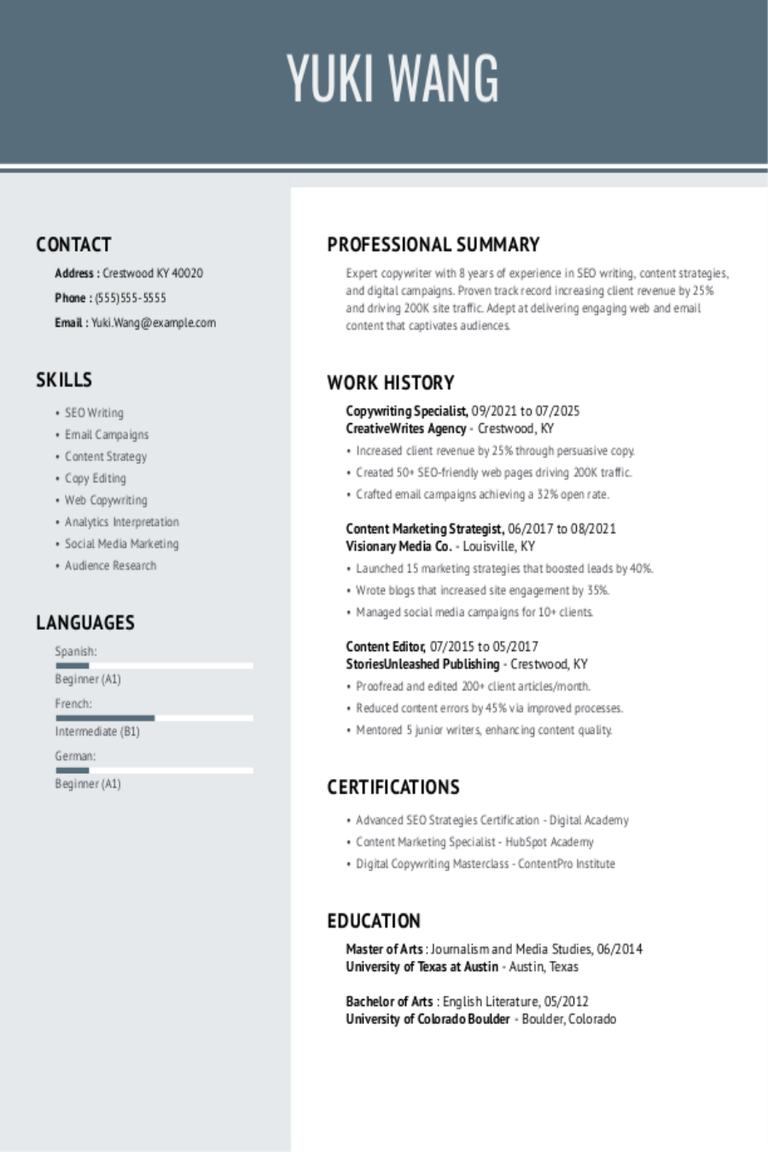
Copywriting Resume Examples & Templates for 2025
Discover copywriter resume examples and tips to learn how to highlight your writing skills, project experience, and ability to craft compelling content.Build my resumeImport existing resumeCustomize this templateWhy this resume

Carpenter Resume Examples + Writing Guide
Crafting a carpenter resume involves more than listing your job duties. Learn how to effectively showcase your building skills, attention to detail, and ability to follow blueprints.Build my resumeImport existing
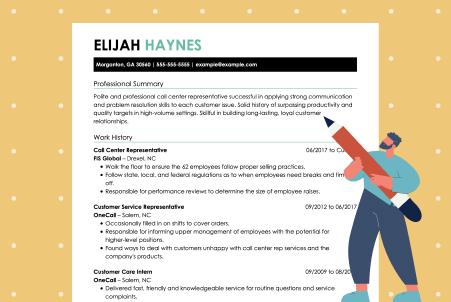
Resume Header Examples & Writing Guide for 2025
Your resume header is the first element of your application that hiring managers see, and it needs to be eye-catching and professional to make a strong first impression. A clear, well-structured
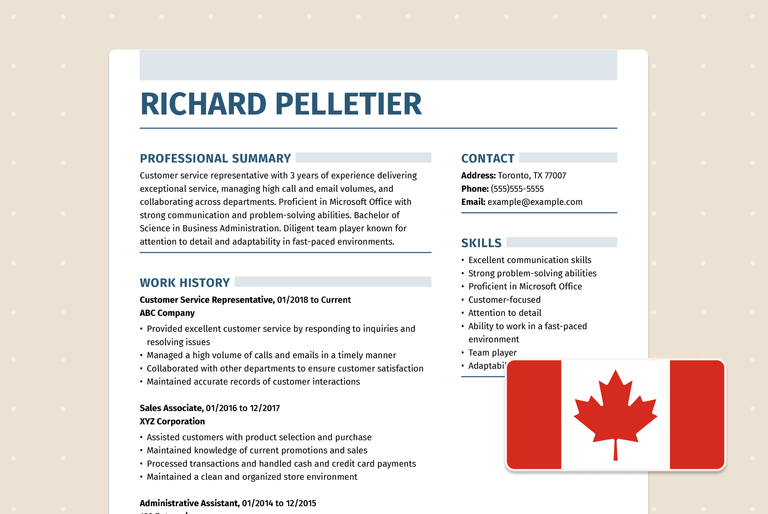
Canadian Resume Format: Writing Guide & Examples
Whether you’re moving north for new opportunities, remote work, or a fresh start, understanding how to write a Canadian-style resume can make all the difference in landing interviews. In this guide,
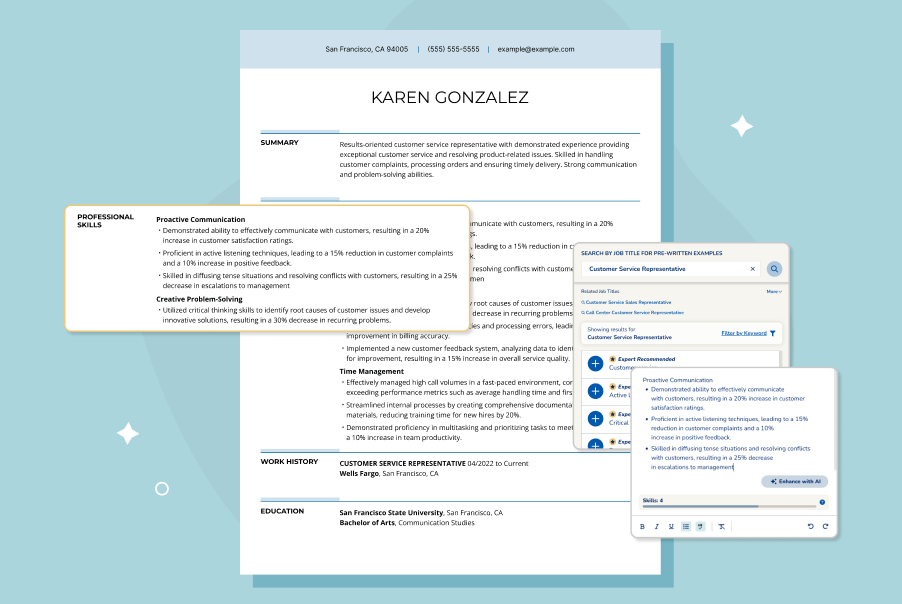
Writing a Skills-Based Resume: Template & Guide
In today’s fast-changing job market, how you tell your career story matters more than ever. Enter the skills-based resume — a powerful tool that highlights what you can do, not
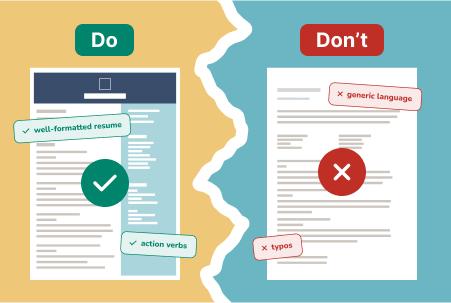
Resume Writing Tips: Do’s and Don’ts
Your resume is often your first impression with potential employers — so make it count! A well-crafted resume can open doors, while common mistakes can send it straight to the rejection
